How to Plant, Grow, and Care for Delphiniums
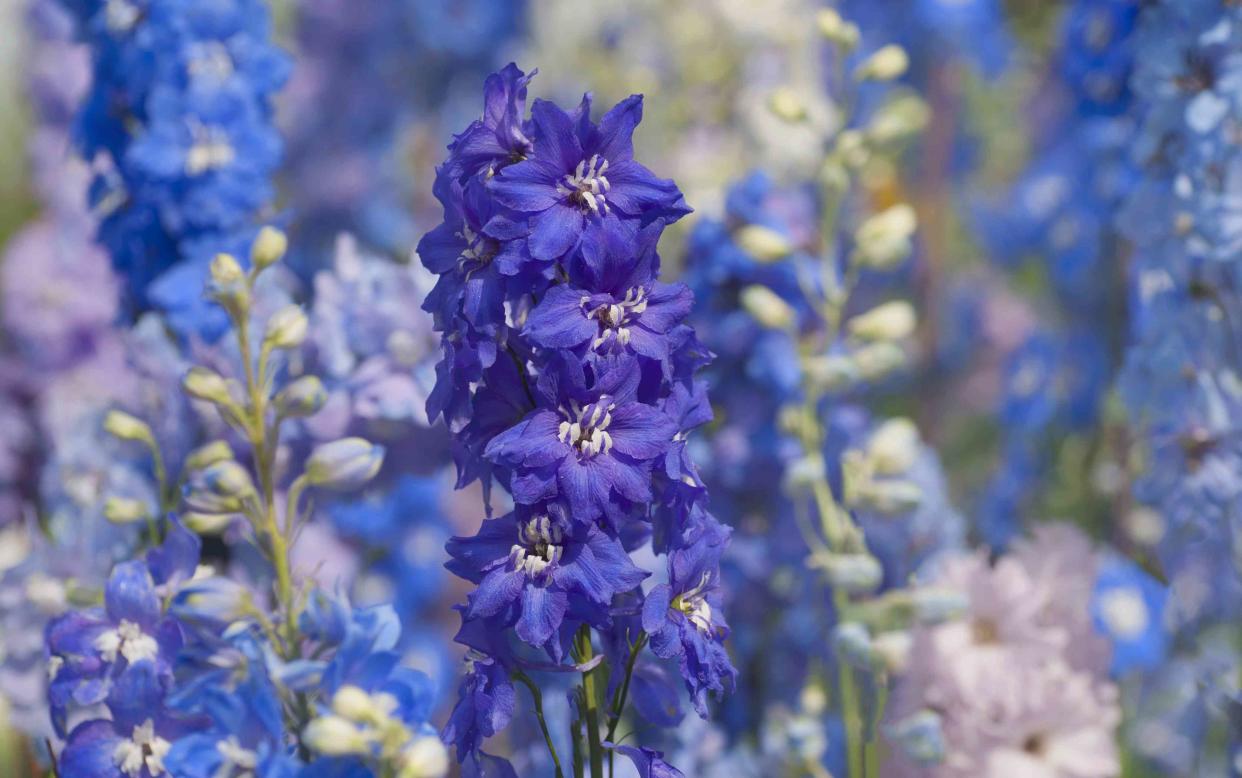
The Spruce / Evgeniya Vlasova
Reviewed by Debra LaGattutaReviewed by Debra LaGattuta
Also called larkspur, delphinium describes a group of plants that produce some of the boldest blooms of summer. The genus includes over 300 species; Delphinium elatum is most easily recognized. This species towers from 5 to 6 feet tall and 2 feet wide. The flowers are most commonly blue but also come in shades of pink, purple, and white. Some types feature a contrasting eye and others produce semi-double or double blooms.
Used often for garden borders, delphiniums are short-lived perennials, lasting just three to five years, and grow best in regions with long, cool spring seasons. They have a sporadic growth rate, seven to 21 days from sowing. Bloom time starts from late spring to early summer and can continue all season. They are toxic to people, pets, and horses.
Common Name | Delphinium, Larkspur |
Botanical Name | Delphinium |
Family | Ranunculaceae |
Plant Type | Herbaceous perennial |
Mature Size | 6 in. to 7 ft. fall |
Sun Exposure | Full sun to part shade |
Soil Type | Moist loam, well draining |
Soil pH | Neutral 6.5 to 7.0 |
Bloom Time | Early spring through summer |
Flower Color | Pastel, blue, pink, purple, white |
Hardiness Zones | 3-9 (USDA) |
Native Area | Non-specific |
Toxicity | Toxic to people, pets and horses |
Planting Delphinium
Planting delphinium successfully comes down to placing them correctly in your yard and in the ground. Here is how to do it right:
When to Plant
Plant delphinium in an area that gets lots of sun in the morning, with shady afternoons in hot regions. Spots with well-draining and loamy soil are best.
When to Plant
Delphiniums do best when they are transplanted, meaning they start growing indoors. Get your seeds started roughly 10 weeks ahead of the last frost of spring.
How to Plant
Look to plant your delphiniums around 10 or so weeks ahead of the last frost. The seeds will germinate sometime between 21 and 28 days. However, if you store your seeds in the fridge a couple of weeks before planting, this might speed up the germination process.
Once spring temperatures are steady (not below 50 degrees Fahrenheit), you can safely transport your delphinium to the garden. Use its existing as a guide for depth and ensure the hole is twice as wide as the root ball. Water frequently until baby plants spring up.
Delphinium Care
The Delphinium group of plants offers plenty of versatility for the home gardener. Here is how to care for them:
Delphiniums need full sun to partial shade, depending on your region.
Choose an area with loamy, well-draining soil with a pH around 7.
Keep soil moist, but not too wet.
Ensure your pants have afternoon shade, as it does not do well in dry heat.
The plant’s tall stocks are susceptible to wind damage, plant them in an area blocked from the wind.
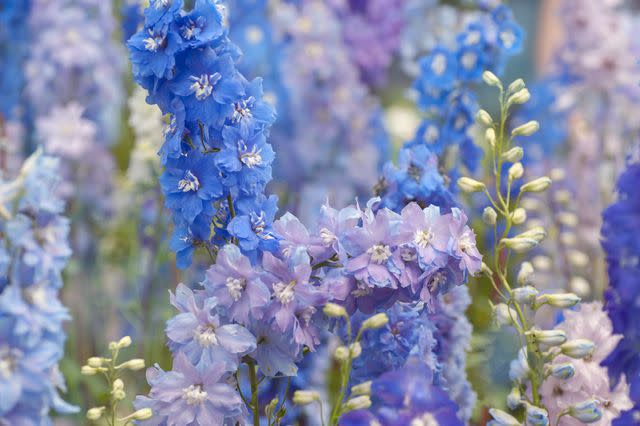
The Spruce / Evgeniya Vlasova
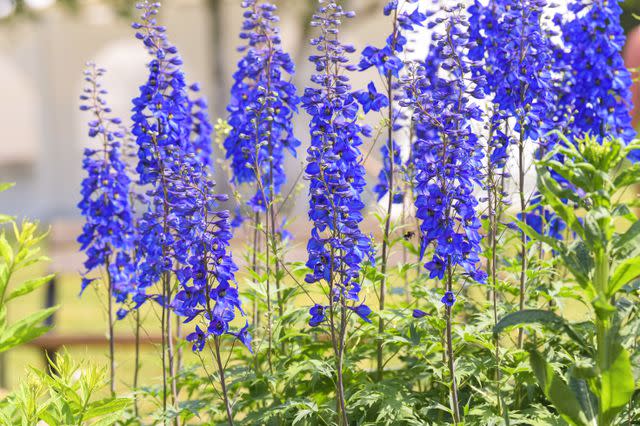
The Spruce / Evgeniya Vlasova
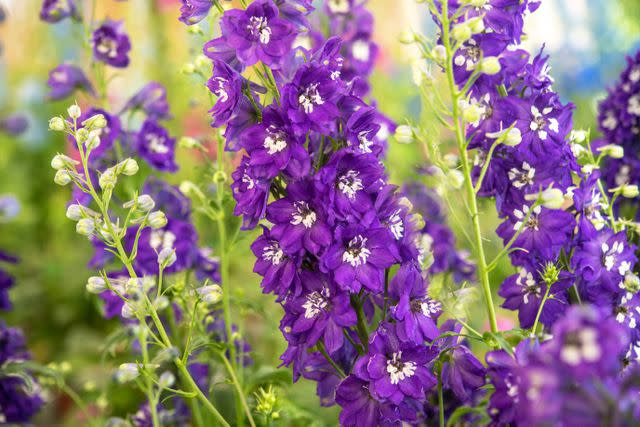
The Spruce / Evgeniya Vlasova
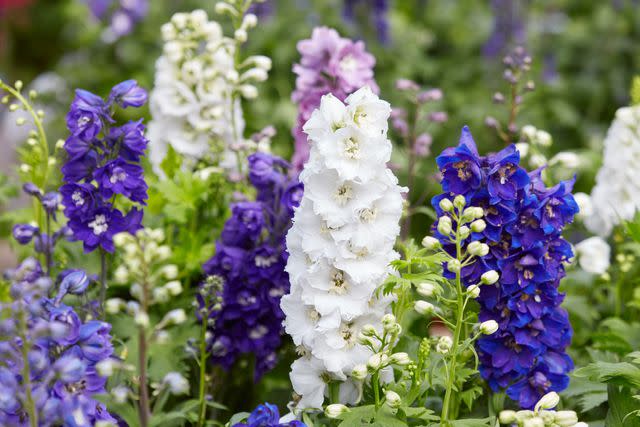
AndreaAstes / Getty Images
Light
Delphiniums put on their best show in plenty of sun, 6 to 8 hours daily. However, this is not a plant that does well in dry heat. A location that offers a morning sun with light afternoon shade during hot weather can improve and extend flowering.
Soil
Well-draining loamy soil with a slightly acidic soil pH of 6.5 to 7.0 yields the best results. Adding compost at planting time boosts growth for these heavy feeders.
Water
Water regularly especially during hot weather. Keep soil moist but not waterlogged because these plants are vulnerable to crown rot. The planting bed should never dry out completely. Water at ground level, do not wet the foliage, to discourage fungal and leaf spot problems. A two to three inch mulch layer preserves moisture in the soil.
Temperature and Humidity
Long, cool springs and cooler summers with average temperatures between 70 and 80 degrees Fahrenheit provide ideal conditions. These plants dislike high humidity and heat, and humidity can encourage powdery mildew to develop. Most perennial types are fully cold hardy to -30 degrees Fahrenheit.
Fertilizer
Delphiniums need plenty of nutrients to produce their showy flower spikes. Work well-aged compost or a balanced fertilizer such as a 10-10-10 into the soil at planting time. A second application mid-season might prolong bloom and support a second bloom period. When leaves start to turn yellow, it's often a sign a nutrient boost is needed.
Types of Delphinium
Many popular and widely available delphiniums are cultivars of D. elatum or D, grandiflora with crosses between the two identified as D. x belladonna. Some are series of plants that share identical features but bloom in varied or combinations of colors.
D, elatum 'Magic Fountain' grows two and a half to three feet tall with flowers in white, white with a dark center, dark blue, sky blue and pink.
D. elatum 'Centurion' features three foot tall, erect stems with semi-double flowers in white, purple shades and blue shades with white eyes,
D. elatum 'Pacific Giant' is usually grown from seed resulting in combinations of bloom colors. This type reaches three to six feet in height.
D. grandiflorum ‘Summer Nights’ is considered a dwarf variety at 10 to 12 inches tall and features midnight blue flowers.
D. x belladonna 'Blue Donna' produces uniform bright blue flowers on multiple branching stems and grows two and a half to three feet tall.
Pruning
Removing mature flower spikes encourages flowering on developing side shoots. Find the axil where branches form off the main stem and use a sterile hand pruner to remove the center flower spike. Once the initial bloom period ends, cut back delphiniums to two inches above ground level to encourage a second late summer or autumn bloom. Cutting back is repeated either in autumn or early spring to encourage new seasonal growth.
During the bloom season, deadhead delphiniums regularly to promote healthy growth. Remove each flower individually as it fades, snipping up to the closest set of leaves or nexus of stems.
Propagating Delphinium
Delphiniums grow and multiply rapidly and are propagated by division and basal cuttings. These methods are most successful in spring when new growth first appears. The plants also self-seed around one year of being in the garden.
However, plants produced by these seeds are typically not true to type—since many popular delphiniums are hybrid crosses—so their color and type will likely be different than the plant they came from.
Propagating By Division
To propagate by division, you'll need a hand spade, watering can, and gloves, Here's how:
Water plants thoroughly 24 hours before to prevent transplant shock.
Choose a section from the outside portion of the clump, removing lengthy stems and excess foliage from your selection.
Starting at five to six inches out from the center, use the hand spade to dig around the section.
Lift it out and gently shake off excess soil.
Choose a new location with direct sun and well-draining soil and work in compost or a balanced fertilizer.
Place each division into a separate hole keeping it at the same soil level as in the original location.
Backfill with garden soil and gently water the new plant at the base.
Propagating by Cuttings
To propagate from basal cuttings you'll need a sharp sterile knife, a small hand spade, three to four inch pots with drainage holes, a well-draining potting medium, compost, and gloves. Here's how:
Choose a shoot two to three inches long and use your gloved hands or a spade to dig down into soil around the shoot.
Use a sharp knife to cut the shoot below soil level, making sure the cut portion is solid and not hollow at the bottom.
Lightly clean to remove soil and trim off excess foliage leaving just one or two leaves.
Place it in a 3-4 inch pot with a combination of compost and perlite or a moist, loose, potting soil. The portion of the cutting growing below soil level should be buried at the same level in the pot as it was in the ground. Alternatively, the cutting can be placed in 1-2 inches of water until roots form.
Keep cuttings in a cool location, preferably at 50 to 55 degrees Fahrenheit, and avoid bottom heat. New growth appears in three to four weeks indicating roots have formed.
Transplant new plants into the garden after the danger of frost has passed.
How to Grow Delphinium From Seed
Delphiniums grow easily from seed, however, not all types reseed. Start seed in winter or early spring or provide cold stratification by placing them in the refrigerator for several weeks. Gather seeds, small pots or a seed tray, a loose potting medium, compost, a plastic covering, and a spray bottle. Follow these steps:
Fill a seed tray or small three to four inch pots with damp, loose soil mix. Sprinkle seeds and cover with 1/8 inch of compost.
Lightly spray with water and cover with a plastic dome or bag.
Keep soil moist and temperature at 70 to 75 degrees Fahrenheit. Germination occurs in three to four weeks.
Once seeds sprout, remove the plastic covering and place the plants in a sunny window.
When seedlings are sturdy enough to handle, transplant them into individual pots.
Continue to repot into slightly larger pots as needed until all danger of frost has passed and it's safe to plant in the garden.
Tip
Whether you are transplanting seedlings, divisions or cuttings, keeping the fine, hair-like roots of delphinium from drying out is essential. Transplant as soon as possible and keep them in a shaded spot.
Potting and Repotting Delphinium
Delphiniums spread rapidly and do not like crowding, so choose a container large enough to hold a plant at least twice the size with plenty of drainage holes. Avoid materials like clay or terracotta that dry out quickly.
Dwarf varieties work especially well, but tall varieties can be grown in pots if wind protection and/or staking is provided. Pots need frequent, regular watering and a balanced fertilizer every two to three weeks.
To pot, fill the container with a loose mix of potting soil and compost or fertilizer. Prepare a wide planting hole in the center of the pot, then place the plant at the same soil level as it was in its original pot. Fill with potting soil or compost. Water thoroughly at the soil level, but do not wet the foliage. Place the pot where it will receive plenty of morning sun and filtered afternoon shade.
Overwintering
Perennial delphiniums are frost-hardy but can be damaged by cold wet soil. Mulching for winter protection discourages frost damage. Potted plants do not need to move indoors but should be protected from wind and excessive wet weather.
Common Pests and Diseases
Delphiniums are susceptible to slugs, aphids, mites, cutworms, stalk borers, and leaf miners. Signs include failure to bloom, deformed flowers, wilting, and blackened, distorted foliage. Inspect plants regularly for signs of trouble and take recommended steps to eradicate the specific pest.
Delphiniums are vulnerable to leaf spot, blight, stunting, root-knot nematodes, and viruses. And also to powdery mildew is caused by high humidity and a soil-borne fungus. Healthy plants are the best defense. Remove diseased plants immediately (especially in the case of crown rot). Avoid soggy soil and overhead watering, keep the planting bed weed-freem and plant disease-resistant varieties.
How to Get Delphinium to Bloom
Failure to bloom can result from inadequate growing conditions. Here is what to consider:
Bloom Months
Delphinium typically blooms in the spring and summer months, between June and September. You can make the blooms last longer by ensuring they get at least six hours of full sun daily and consistently moist soil. Provide plenty of nutrients, but keep in mind that too much nitrogen can result in lush foliage at the expense of flower development.
Delphiniums will bloom every year with the proper care, for example, enough water and pruning after they bloom.
What Do Delphinium Flowers Look and Smell Like?
Delphinium flowers are small, star-like blooms that are clustered at the top of the plant's stalks, typically in rich shades of blue, purple, and pink as well as white. They smell light and sweet and are fairly subtle in comparison to other flowers' scents.
How to Encourage More Blooms
Extend the bloom period by removing the center bloom spike when flowers begin to drop. When the initial bloom period ends, cut the plant back to two inches to encourage a second bloom period.
Common Problems With Delphinium
Overcrowding
These plants spread rapidly and do not like to compete for space. Overcrowding inhibits air circulation which can lead to powdery mildew and the spread of other fungal and bacterial problems. Divide or thin new growth in early spring to alleviate this problem.
Yellow leaves
Delphinium foliage should be uniform blue-green in color. Yellowing foliage is caused by overwatering and also could be a sign the plant lacks nutrition. Grow delphiniums in a location or in pots with good drainage and feed them regularly.
Drooping Plants
This is a problem especially with tall varieties. Hollow stems with heavy flower spikes need support. Install stakes or grow delphiniums against a trellis or fence. Flimsy plants can also result from not enough sunlight.
Frequently Asked Questions
Do Delphinium come back every year?
Many species and cultivars of delphiniums developed for home gardens are short-lived perennials that come back for up to five years, Annual species include native larkspur which are often shorter with smaller flowers and fern-like foliage.
Where should I plant delphiniums?
You should plant delphiniums in an area that gets 6-8 hours of sun per day, with shady afternoons and well-drained soil that is slightly acidic. Plant them far enough apart to ensure each plant gets good air circulation.
What is the difference between larkspur and Delphinium?
Larkspur is a common name often applied to delphiniums but larkspur also can refer to plants in a different genus. Most larkspur are annuals while most delphiniums are perennial. The two plants can usually be identified by differences in foliage and flower size which is larger in delphiniums.
Read the original article on The Spruce.
